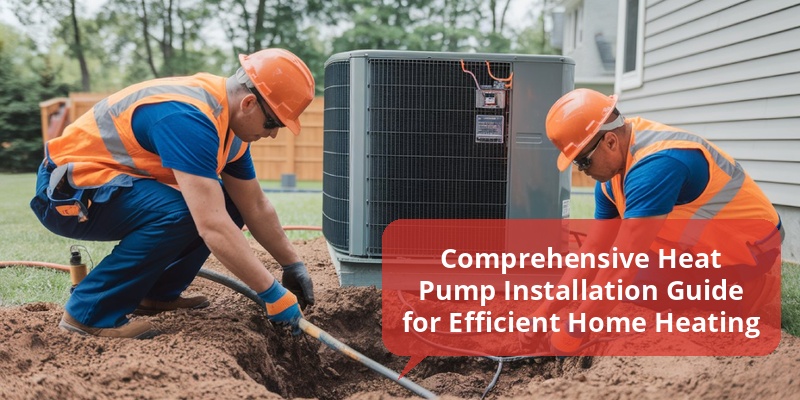Installing a heat pump can significantly improve residential energy efficiency and comfort. This comprehensive heat pump installation guide covers essential steps, considerations, and best practices to ensure optimal performance and longevity of your system.
| Key Aspect | Details |
|---|---|
| System Types | Air-Source, Ground-Source, Water-Source |
| Site Assessment | Location, Climate, Space, and Electrical Compatibility |
| Installation Process | Preparation, Equipment Setup, Electrical & Refrigerant Connections |
| Cost Considerations | Equipment, Labor, Permits, and Potential Rebates |
| Maintenance Tips | Regular Filter Change, System Inspection, Professional Servicing |
Types of Heat Pumps Suitable for Home Installation
Heat pumps vary primarily by their heat exchange medium. The three main types are air-source, ground-source (geothermal), and water-source. Air-source heat pumps are the most common residential systems due to their affordability and ease of installation. Ground-source heat pumps use underground temperature stability, offering superior efficiency but require extensive site work. Water-source pumps harness geothermal or surface water heat sources when available, usually in larger or specialized settings. Choosing the right type depends on local climate, property characteristics, and budget.
Evaluating Your Home for Heat Pump Installation
A thorough site evaluation ensures the heat pump will operate efficiently. Key factors include the local climate, available space for outdoor units, existing heating infrastructure, and electrical system adequacy. Homes in moderate climates benefit most from heat pumps due to their efficiency in both heating and cooling. Additionally, verify zoning restrictions and acquire necessary permits if required. A professional energy audit can provide valuable insights into insulation quality and existing HVAC compatibility.
Step-By-Step Heat Pump Installation Process
Preparing the Installation Site
Begin by selecting an optimal location for the outdoor unit, preferably a shaded, level area free from obstructions. Indoors, ensure the indoor unit location facilitates good air circulation and minimal noise disturbance. Clear any debris and secure all necessary materials and tools before starting.
Mounting the Units
Install the outdoor compressor unit on a stable, weather-resistant base such as a concrete pad or vibration-absorbing mounts to minimize noise and wear. The indoor air handler should be positioned to promote efficient airflow to the home’s living areas.
Connecting Refrigerant Lines and Electrical Wiring
Heat pump systems require properly insulated refrigerant lines connecting the indoor and outdoor units. Electrical connections must comply with local codes, supporting the heat pump’s power requirements safely. This step should be handled by licensed electricians and HVAC professionals.
System Testing and Calibration
After installation, thoroughly test the system for refrigerant leaks, electrical integrity, and operational efficiency. Calibrate thermostats and controls for optimal temperature regulation. Performing system diagnostics identifies potential issues early.
Cost Analysis and Financial Considerations
The total cost of heat pump installation depends on the system type, home size, and complexity of installation. Air-source heat pumps typically range from $3,500 to $7,500, while geothermal systems can exceed $20,000 due to drilling and excavation. Factor in additional expenses such as permits, electrical upgrades, and ductwork modifications. Homeowners should explore federal, state, and local incentives, including rebates and tax credits, which can reduce upfront costs significantly.
Maintenance and Longevity of Heat Pump Systems
Regular maintenance is critical for sustaining heat pump efficiency. Tasks include replacing or cleaning air filters monthly during heavy use periods, inspecting refrigerant levels, and ensuring condensate drains are clear. Annual professional servicing verifies system health, checks electrical components, and recharges refrigerant if necessary. Well-maintained heat pumps can last over 15 years, providing consistent comfort and energy savings throughout their lifespan.
Common Installation Challenges and How to Address Them
Challenges such as improper sizing, inadequate insulation, or poor placement can reduce heat pump effectiveness. Oversized units cycle frequently, wasting energy, while undersized systems struggle to maintain comfort. Ensuring proper duct sealing and insulation optimizes airflow and heat retention. Consulting with certified HVAC installers prevents common pitfalls and enhances overall system performance.
Innovations in Heat Pump Technology
Recent advancements have improved heat pump performance in colder climates, expanding their usability. Variable-speed compressors and enhanced refrigerants allow efficient operation even below freezing temperatures. Smart thermostats and system controls simplify user interface and enable remote monitoring, contributing to better energy management and cost savings.
Environmental Benefits of Using Heat Pumps
Heat pumps use electricity instead of fossil fuels, reducing carbon emissions significantly when paired with renewable energy sources. Their high efficiency means lower overall energy consumption for heating and cooling, contributing to reduced environmental impact. Transitioning to heat pumps is a vital step toward sustainable residential energy use.
